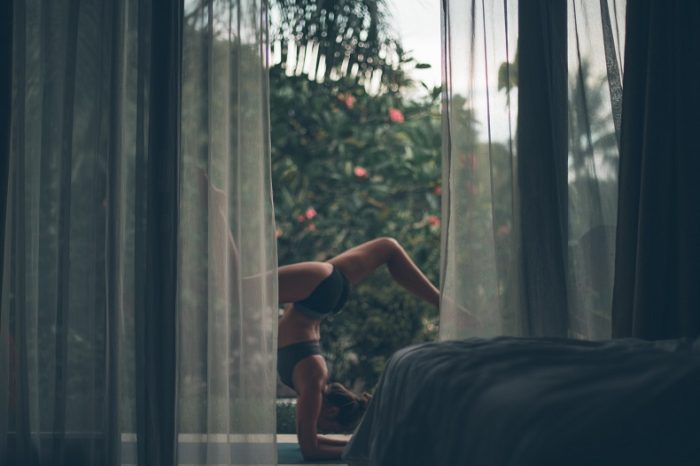Once upon a time, I wrote an article stating that if you teach yoga, you must have a daily self-practice.
That article was widely shared and read—and it triggered some strong reactions.
There were comments and emails, in which people shared the reasons why they couldn’t practice yoga every day. Some of these yoga teachers were only teaching one class a week, on top of working 50+ hour jobs, and they were often teaching disadvantaged groups. They felt like what they were doing was important, regardless of whether or not they were practicing daily.
I agree—teaching yoga is valuable and important, no matter how many classes a week you teach. And even more so when you’re reaching people who don’t or can’t walk into yoga studios.
That means your self-practice becomes even more important—to hold you and your students in that space. Yet, as I read through the many comments, messages and emails, one thing became very clear: people have a fixed idea that a daily home yoga practice means two things in particular.
- Practicing asana.
- Practicing for at least an hour a day.
This fixed idea of what it means to practice yoga daily means that people who need to practice daily—teachers—are confronted with feelings of guilt, inadequacy, or failure, because the nature of their lives means it is impossible to meet this demand.
These were often the teachers who contacted me—they care deeply about their students and their practice, yet felt unable to meet the demand I was imposing. They were hurt because they felt like they were doing their best, and I was suggesting it wasn’t good enough and that they were failing or harming their students.
It was clear to me that more dialogue was required around this.
First, if you are teaching yoga—even just one class a week—I am still unequivocal in stating that doing so requires you practice yoga every single day.
This means self-practice, daily, on top of whatever classes you may be attending or DVDs you may be using. Showing up to a yoga class is not self-practice. It’s a great way to get inspired, to connect with the yoga community, to work with a teacher, to go deeper, or to hone your practice.
But it is not self-practice—and self-practice is where the juice we need to teach comes from.
Yes, there may be the odd day here and there where self-practice doesn’t happen. But your intention is daily practice, and you arrange your life and yourself in such a way that this happens.
But here’s the kicker. Daily yoga practice does not mean you have to do 60 minutes of asana every day, or 45 minutes, or even 30 minutes.
Daily yoga practice means that you show up to yourself, using a tool of yoga on a daily basis for at least seven minutes.
That means you might do asana, or pranayama, or meditation, or chanting. It also means you may read texts like The Yoga Sutras or The Bhagavad Gita. It may mean study of other texts like Stephen Cope’s Yoga & The Quest for the True Self. It may also mean discussion with other yoga teachers about the practice and living of yoga. It may mean self-study (svadhyaya).
All of these things are “yoga” and deepen our understanding of the practice and ourselves. They all support our own practice and our teaching. Of course, it’s useful that you spend time practicing whatever it is that you’re teaching. And when you can spend longer than seven minutes on the mat, you will reap greater benefits.
But in essence, it does not matter what aspect of yoga you practice, nor does it matter if you only turn up for seven minutes.
What matters is that you show up, every single day.
Because in the showing up, something begins to happen. Your practice is steady—every day, there you are. But what is not steady is your mind—it will fluctuate wildly.
Some days you will be aching to get to your practice, and some days you will want to flee to outer Mongolia to avoid your practice. Some days you will be so present and so deep, and some days you will be flitting off everywhere unable to focus for even a moment.
The yoga arises as you witness yourself in these fluctuations. This is the yoga.
Not the postures. Not even the pranayama, or meditation, or chanting.
No, the yoga is our relationship to the practice. The practice itself exists only to hold us in place and provide a platform to project the unconscious ruminations of the mind, so we can see them clearly.
It is only by holding ourselves to daily consistency that we can begin to notice these fluctuations, that we can begin to inquire into them, and that we can begin to understand what the fluctuations reveal about who we think we are.
Through these observations, we can get a clearer idea of what it is that we need in our practice. So we can then adjust our practice to meet us, rather than impose what we think we should be doing.
Along the way, the practices will work on our physical, emotional, mental, and energetic bodies. They will clear out blockages and purify us so that we can perceive reality more clearly. This will make us far better teachers than we otherwise would be.
Understand too, that mat resistance is a normal part of daily yoga practice.
Ten years into teaching, 16 years into home practice, and I still encounter internal resistance to getting on my mat (especially for asana practice—not so much for meditation). I just don’t want to do it.
But then, who is the ‘I’ that doesn’t want? That’s the first question to ask.
And then, the second question to ask when you hit mat resistance is “What am I afraid of?” Because when you don’t want to get on the mat—when you’re feeling physically repelled from practicing—there’s something you don’t want to look at. There’s something you don’t want to feel. There’s something you don’t want to face.
This is the practice—showing up and seeing what we don’t want to see, feeling what we don’t want to feel, and facing what we don’t want to face.
It’s no wonder that daily home practice is so difficult. It’s no wonder than even yoga teachers struggle to do it.
I was amazed when I published 40 Days of Yoga, and other yoga teachers began to buy the book in droves.
You teach yoga! Don’t you have a daily home practice already?
But no…these teachers didn’t. No one had ever taught them how to practice at home. No one had ever laid out the territory they would be traversing, the tools they would need, the challenges they would face. They were desperate for something that would help them show up every single day.
So if you struggle to practice yoga daily—don’t despair. This is normal. This is the practice. All yoga teachers struggle.
The way forward starts with an intention—call it a sankalpa if you will—an intention that you care about your practice, and you care about your students, and you are going to show up to your practice every single day.
Seek out resources to help you with this process. Team up with other practitioners who want to practice daily. Do whatever you need to do to support yourself in this process. (And yes, I highly recommend 40 Days of Yoga. It works.)
Get clear—yes, I want to practice daily. Define what that means for you. Then show up. No matter what.
When you miss a day (which you will), figure out why—what went wrong on that day for you? Address whatever it was. Come up with a new strategy to get around that obstacle. And then, start again with your daily practice. Again, and again, and again, and again.
In time, it does become easier. Although mat resistance seems to still show up.
Whatever happens in the face of daily practice—any kind of defensiveness, any kind of resistance, any kind of contraction, any kind of shrinking—that is the juice right there. That is the mind being laid bare for you to see and work with, that is your unconscious beginning to become conscious.
This. Is. The. Yoga.
See you on the mat.
~
Ready to join?
Hey, thanks so much for reading! Elephant offers 1 article every month for free.
If you want more, grab a subscription for unlimited reads for $5/year (normally, it's $108/year, and the discount ends soon).
And clearly you appreciate mindfulness with a sense of humor and integrity! Why not join the Elephant community, become an Elephriend?
Your investment will help Elephant Journal invest in our editors and writers who promote your values to create the change you want to see in your world!
Already have an account? Log in.
Ready to join?
Hey, thanks so much for reading! Elephant offers 1 article every month for free.
If you want more, grab a subscription for unlimited reads for $5/year (normally, it's $108/year, and the discount ends soon).
And clearly you appreciate mindfulness with a sense of humor and integrity! Why not join the Elephant community, become an Elephriend?
Your investment will help Elephant Journal invest in our editors and writers who promote your values to create the change you want to see in your world!
Already have an account? Log in.
Ready to join?
Hey, thanks so much for reading! Elephant offers 1 article every month for free.
If you want more, grab a subscription for unlimited reads for $5/year (normally, it's $108/year, and the discount ends soon).
And clearly you appreciate mindfulness with a sense of humor and integrity! Why not join the Elephant community, become an Elephriend?
Your investment will help Elephant Journal invest in our editors and writers who promote your values to create the change you want to see in your world!
Already have an account? Log in.
 Share on bsky
Share on bsky






Read 0 comments and reply